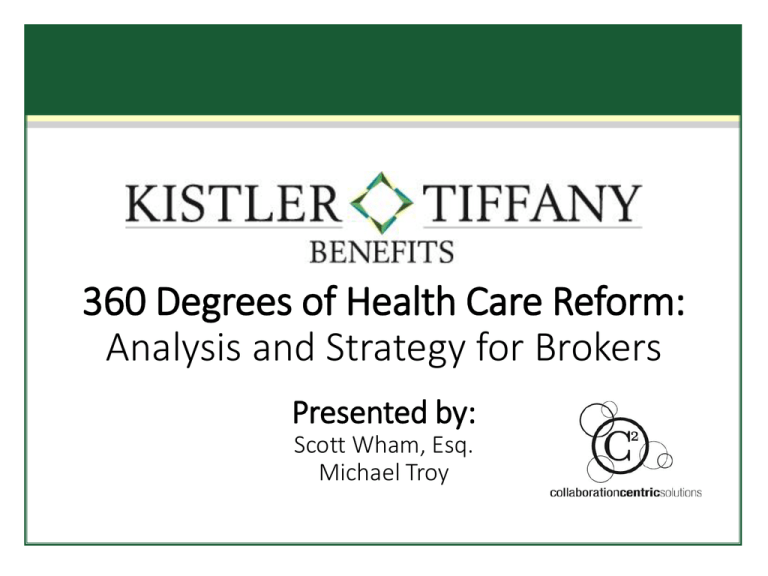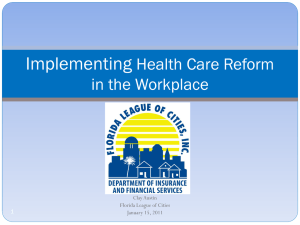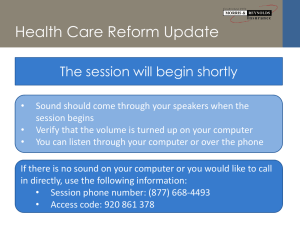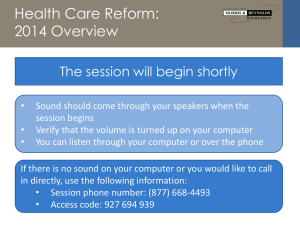360 Degrees of Health Care Reform
advertisement

360 Degrees of Health Care Reform: Analysis and Strategy for Brokers Presented by: Scott Wham, Esq. Michael Troy Small Group Defined Employer Contribution: 29 CFR 1625.10(d)(4)(ii) (ii) As a condition of participation in a voluntary employee benefit plan. An older employee within the protected age group may be required as a condition of participation in a voluntary employee benefit plan to make a greater contribution than a younger employee only if the older employee is not thereby required to bear a greater proportion of the total premium cost (employer-paid and employee-paid) than the younger employee. Otherwise the requirement would discriminate against the older employee by making compensation in the form of an employer contribution available on less favorable terms than for the younger employee and denying that compensation altogether to an older employee unwilling or unable to meet the less favorable terms. Such discrimination is not authorized by section 4(f)(2). This principle applies to three different contribution arrangements as follows: (A) Employee-pay-all plans. Older employees, like younger employees, may be required to contribute as a condition of participation up to the full premium cost for their age. (B) Non-contributory (“employer-pay-all”) plans. Where younger employees are not required to contribute any portion of the total premium cost, older employees may not be required to contribute any portion. (C) Contributory plans. In these plans employers and participating employees share the premium cost. The required contributions of participants may increase with age so long as the proportion of the total premium required to be paid by the participants does not increase with age. Employer Mandate Generally, IRS Code Section 4980H (“The Employer Shared Responsibility Provisions,” “Pay-or-Play”) requires Applicable Large Employers with 50 or more full-time equivalent employees (FTEs) to offer coverage to full-time employees and dependent children up to age 26, or potentially pay penalties Employer Mandate Penalties • Sledgehammer (Generally) • If coverage is not offered to substantially all full-time employees, and one full-time employee receives a subsidy to buy health insurance through a gov’t sponsored Marketplace, employer will pay: • [$2,000 x (number of full-time employees - 30)] • Note: Special rules for Sledgehammer apply in 2015we’ll discuss later • Tackhammer Penalty • If coverage is offered but is not 1.) affordable, or 2.) does not provide minimum value, employer will pay: • $3,000 per full-time employee who receives a subsidy through gov’t sponsored Marketplace QUICK GROUND RULE! Full-Time Employee • An employee who averages 30 hours of service per week, or 130 hours per month • This is not always easy identifyMuch, MUCH more on this later! Employer Mandate Four Key Questions for 2015 • 1.) Is the employer subject to the Employer Mandate? • 2.)If so, on what date must the employer comply? • 3.) Who must be offered coverage in order to comply with the Employer Mandate? • 4.) What are the potential penalties and how do we protect against them? Transition Relief The final regulations provide multiple types of transition relief • Transition relief for employers with at least 50 FTEs but fewer than 100 • Transition relief for employers with 100 or more FTEs • Non-Calendar Year Plans • Pre-2015 eligibility transition relief • Significant percentage transition relief (all employees) • Significant percentage transition relief (full-time employees) • Transition relief for Dependent Coverage FTE Calculation to determine Applicable Large Employer status The FTE calculation is only used to determine whether a group is an Applicable Large Employer • Perform the calculation using data from the previous calendar year • Must be performed across controlled groups • Employers must aggregate group size across controlled groups • EXAMPLE: A controlled group consisting of 10 commonly owned companies where each member employs 20 FTEs has a total FTE count of 200each member is treated as a large employer (assessed independently for compliance) FTE Calculation (Cont’d) • To determine group size: • Calculate for each calendar month in 2014, take the yearly average • Number of full-time employees • Number of full-time equivalents • Add all hours worked by non-full-time employees in a given month (capped at 120 hours) and divide by 120Resulting value= FTEs • Can round to the nearest one hundredth (i.e. 30.544 FTEs for a calendar month = 30.54 FTEs) • FOR 2014May use any six consecutive calendar months to perform this calculation FTE Calculation (Cont’d) • Hours of Service (Generally): • “..each hour for which an employee is paid, or entitled to payment, for the performance of duties for the employer, and each hour for which an employee is paid, or entitled to payment by the employer for a period of time during which no duties are performed due to vacation, holiday, illness, incapacity (including disability), layoff, jury duty, military duty or leave of absence.” • Hourlyentitled to payment • Salaryreasonable method • may use equivalenciesi.e., any day worked = 8 hours FTE Calculation (Cont’d) • Seasonal Workers • An employer is not considered to employ more than 50 full-time employees if 1.) the employer’s workforce exceeds 50 full-time employees for 120 days or fewer during the calendar year, and 2.) the employees in excess of 50 employed during such 120-day period are seasonal workers • NOTEemployers may use 4 calendar months instead of 120 days • Need not be consecutive • So what‘s a “seasonal worker?” FTE Calculation (Cont’d) • Seasonal Worker • Under the final regulations, a seasonal worker means a worker who performs labor or services on a seasonal basis, including (but not limited to): • Workers covered by 29 CFR 500.20(s)(1). (“Labor is performed on a seasonal basis where, ordinarily, the employment pertains to or is of the kind exclusively performed at certain seasons or periods of the year and which, from its nature, may not be continuous or carried on throughout the year. A worker who moves from one seasonal activity to another, while employed in agriculture or performing agricultural labor, is employed on a seasonal basis even though he may continue to be employed during a major portion of the year.”); and • Retail workers employed exclusively during holiday seasons. • Reasonable Good Faith Definition of Seasonal Worker Transition Relief: 50 to 99 FTEs • No penalties imposed for failure to comply with employer mandate until 2016 • Applies to calendar year and non-calendar year plans • Must not modify plan year to begin on a later date (after Feb 9, 2014) • Certification of compliance required Transition Relief: 50 to 99 FTEs (Cont’d) • Must Maintain Group Size • Employers may not reduce workforce for the sole purpose of qualifying for the transition relief • Reductions in workforce must be for a bona fide business reason • Example • A company with 101 FTEs may not lay off a full-time employee for the sole purpose of qualifying for the transition relief Transition Relief: 50 to 99 FTEs (Cont’d) • Must Maintain Coverage • Between Feb 9, 2014 and Dec. 31, 2015, an employer may not eliminate or materially reduce the coverage offered to eligible employees • Must maintain employer contribution to employee-only coverage that is at least: • 95% of the dollar amount contributed on Feb 9, 2015; or • Same (or greater) percentage of the cost of coverage contributed on Feb. 9, 2015 • Must continue to offer minimum-value coverage • Must not reduce classes of eligible employees/dependents Transition Relief: 50 to 99 FTEs (Cont’d) • Employers must certify to the IRS that it meets the following conditions: • Employs between 50 and 99 FTEs • Did not reduce workforce/hours in order to qualify • Maintains previously offered coverage 2015 Transition Relief for Employers with 100+ FTEs • NO EMPLOYER MANDATE DELAY for employers with 100+ FTEs, however, new transition relief applies: • Sledgehammer Penalty • Employers with 100+ employees will not be assessed “Sledgehammer Penalties” if they offer minimum essential coverage to at least 70% of full-time employees (rather than 95%) • Returns to 95% in 2016 • The maximum Sledgehammer Penalty is the number of full-time employees minus 80 (rather than 30) • Returns to 30 in 2016 • Many Non-Calendar Year Plans will be able to postpone exposure until start of the 2015 plan year Pre-2015 Eligibility Transition Relief for Non-Calendar Year Plans • IF: • Employer had a plan in place on December 27, 2012 and • Employer did not modify plan year after December 27, 2012 to begin at a later date • THEN: • Transition relief applies for employees who would be eligible for coverage on the first day of the 2015 plan year according to the eligibility terms on February 9, 2014 Pre-2015 Eligibility Transition Relief for Non-Calendar Year Plans (Cont’d) • No penalties will apply for months prior to the start of the 2015 plan year if employees who are currently eligible are offered coverage effective the first day of the 2015 plan year that is: • Affordable, and • Provides minimum value • EXAMPLE: • George, Michael, & Wham LLC has a plan year of June 1, 2014, and currently offers a group health plan to its full-time employees that meets minimum value, but the plan is not affordable for some full-time hourly employees. George, Michael, & Wham LLC will not be penalized for the months of January to May if it makes the plan affordable beginning on June 1, 2015. Significant Percentage Transition Relief: ALL EMPLOYEES • IF: • Non-calendar year plan in place as of December 27, 2012, and plan year was not changed after December 27, 2012 to begin at a later date, and • At any time during the 12 months prior to February 9, 2014: • Covered 25% of all employees; or • Offered coverage to at least 33% of its employees during the most recent open enrollment period • THEN: • Employer will not be penalized for months in 2015 prior to the start of plan year if affordable, minimum value coverage is offered to full-time employees at the start of the 2015 plan year Significant Percentage Transition Relief: FULL-TIME EMPLOYEES • IF: • Non-calendar year plan in place as of December 27, 2012, and plan year was not changed after December 27, 2012 to begin at a later date, and • At any time during the 12 months prior to February 9, 2014: • Covered 33% of full-time employees; or • Offered coverage to at least 50% of its employees during the most recent open enrollment period • THEN: • Employer will not be penalized for months in 2015 prior to the start of plan year if affordable, minimum value coverage is offered to full-time employees at the start of the 2015 plan year Default Effective Date for 100+ Employers • Calendar year plans1/1/15 • Employers without coverage1/1/15 Who must be offered Coverage? • In order to avoid penalty liability, Applicable Large Employers must offer coverage to full-time employees (30+ hours of service) • If an employee is reasonably expected to work 30+ hours per week, an employer will not be subject to Sledgehammer Penalty if the employee is offered coverage by the 1st day following 3 full calendar months of employment • Employer will not be subject to Tackhammer Penalty if coverage is affordable and provides minimum value New Hire Full-Time Example • Example: • Full-time EE begins work on April 15themployer will not be subject to penalty if EE is offered coverage by August 1 (May, June, July = 3 full calendar months) Variable Hour/Part-Time Employees • Variable Hour Employee • Based on the facts and circumstances at the employee’s start date, the employer cannot determine whether the employee is reasonably expected to be work 30 hours per week during an initial measurement period • Part-Time • Reasonably expected at start date not to be full-time (<30 hrs per week) • Treated the same as variable hour employees (e.g. use look-back) Seasonal Employees • Seasonal Employees • “A seasonal employee means an employee in a position for which the customary annual employment is six months or less.” • An employee in this position typically works six months or less, and • The period of work begins each year at about the same time • Can extend beyond 6 months for anomaly related to the seasone.g. an especially heavy snow season at a ski resort Measurement Period for Ongoing Employees • Ongoing Employees Employees who have worked longer than a Standard Measurement Period • Standard Measurement Period3-12 months • Recommend 12 month look-back for ease of administration Administrative PeriodUp to 90 days • Spans between end of Standard Measurement Period and start of Plan Yearallows employer to assess who must be classified as full-time based on average hours worked during Standard Measurement Period (look-back period) Stability PeriodGreater of 6 months or length of measurement period (12 month Standard Measurement Period= 12 month Stability Period) • Period during which an employee is either classified as full-time or part-time depending on average hours worked during Standard Measurement Period • • Measurement Period for Ongoing Employees (EXAMPLE) • George, Michael, Wham LLC is an ALE with a plan year of 1/1/15. • • • Standard Measurement Period • Oct. 14, 2014 LOOKING BACK to Oct. 15, 2013 • Assess whether employees averaged 30 hours per week or more during this period Administrative Period • Oct. 15, 2014 Dec. 31, 2014 • Assess which employees must be classified as full-time for 2015 stability Stability Period • Jan. 1, 2015 Dec. 31, 2015 • Period during which employees who averaged 30 hours per week or more during Standard Measurement Period must be classified as full-time Transition Relief for SMPs • Going into 2015, employers may face time constraints if they want to use a 12-month SMP and a 12-month stability period • May use a shorter SMP and 12-month stability period if: • SMP is shorter than 12 months, but not less than 6 consecutive months; and • Begins no later than July 1, 2014 and ends no earlier than 90 days before the first day of the plan year beginning on or after Jan. 1, 2015 Initial Measurement Period for New Part-Time, Variable Hour, and Seasonal Employees • Initial Measurement Period3 and 12 consecutive months • Must begin on the employee’s start date or on any date up to and including the first da of the first calendar month following the employee’s start date (or on the first day of the first payroll period starting on or after the employee’s start date, if later) • Recommend using 12 month Initial Measurement Period • Administrative Period up to 90 days in total • cannot extend beyond the last day of the first calendar month beginning on or after the one-year anniversary (13 months and a fraction of a month) • Stability Period no less than 6 months up to 12 months • Begins after Administrative Period Initial Measurement Period for New Part-Time, Variable Hour, and Seasonal Employees: EXAMPLE • Andrew Ridgely began working for George, Michael, Wham LLC on April 16th, 2015. • George, Michael, Wham LLC uses a 12 month Initial Measurement period beginning the first of the month following the start date (begins May 1, 2015 and ends April 30, 2016) • Andrew averaged 36 hours per week during the Initial Measurement PeriodFull-time employee for subsequent Stability Period • In order for George, Michael, Wham LLC to avoid penalty exposure, Andrew must be offered coverage that provides minimum value and is affordable by June 1, 2016 effective through May 31, 2017 Monthly Measurement Period • Full-time employees are identified based on their hours of service for each calendar month • Not based on averaging hours of service over a prior measurement period • May cause practical difficulties for employers with employees who have variable scheduleslots of movement in and out of classifications Monthly v. Lookback for Different EE Groups • Generally, must use same measurement method for all employees • An employer, however, may apply either the monthly measurement method or the look-back measurement method to the following groups of employees Each group of collectively bargained employees covered by a separate bargaining agreement Employees whose primary place of employment are in different states Salaried and hourly employees Collectively bargained and non-collectively bargained employees Breaks in Service Rules • If an employee is terminated, may be treated as a new hire upon return if: • Employment break period is 13 weeks or greater (26 weeks for educational organizations); or • Rule of Parity (Optional) • Employment break is longer than period actually worked (must be at least 4 consecutive weeks) • Example: • EE works for 6 weeks, is terminated, and then returns 7 weeks later may be treated as a new hire Avoiding Penalty Liability • Sledgehammer Penalty • 2015 • Offer minimum essential coverage to at least 70% of fulltime employees • If fail to meet threshold [$2,000 x (# of Full-Time Employees – 80)] if one employee goes to Marketplace and receives a subsidy • Assessed Monthly: $166.67 per full-time employee after the first 80 • 2016 • Offer minimum essential coverage to at least 95% of fulltime employees and dependent children to age 26 • If fail to meet threshold [$2,000 x (# of Full-Time Employees – 30)] if one employee goes to Marketplace and receives a subsidy Avoiding Penalty Liability: Transition Relief for Dependent Children • Generally, the Employer Mandate requires ALEs to offer coverage to full-time employees and their dependent children up to age 26 • NO PENALTY WILL APPLY in 2015 for plans that: • do not offer coverage to dependents OR • Offer dependent coverage that is not considered minimum essential coverage; OR • Offer coverage to some but not all dependents • Transition relief will NOT apply if employer drops dependent coverage; and • Employer must take steps during the 2014-2015 plan year to extend coverage to dependents who are not offered coverage during the 2013 or 2014 plan years Avoiding Penalty Liability (Cont’d) • Tackhammer Penalty Liability • ALE must offer coverage to Full-Time Employees that • Provides minimum value • AV rating of 60%akin to a Bronze Level Plan in small group/individual market • Is affordable • Cost for employee-only coverage does not exceed 9.5% of full-time employee’s household income (usually, not known by employer) • Safe Harbors for Affordability • W-2, Rate of Pay, and Federal Poverty Level • If employee-only coverage is unaffordable and/or does not provide minimum value $3,000 per full-time employee who goes to Marketplace and receives a subsidy (capped at Sledgehammer liability) Affordability Safe Harbors • W-2: The Unsafe Safe Harbor? • Cannot reattribute contributions to 401(k) or pre-tax contributions to benefits • Cannot rely on prior year’s Form W-2must project current year W-2 earnings • Cannot impute income for periods of unpaid leave • Rate of Pay Safe Harbor • Hourly Employees • Rate of Pay x 130 hours x 9.5% • Salary Employee • Monthly gross salary x 9.5% • Federal Poverty Level • Employers may use the most recently published poverty guidelines as of the first day of the plan year; or • May use guidelines effective 6 months prior to plan year (provides time to prepare) • (FPL x 9.5%) / 12 months • 2014 FPL for Individual ($11,670 x 9.5%) /12 = $92.39/month Special Categories of Employees: Student Employees • Student Employees • No general exception for student employees • All hours worked for an educational organization OR an outside employer for which the student is paid or entitled to payment must be counted UNLESS it’s part of a Government-Sponsored Work-Study Program Special Categories of Employees: Adjunct Faculty • Adjunct Faculty • May use any reasonable method of crediting hours of service • Must not substantially understate actual hours of service • NEW2 ¼ hours per week for each hour of classroom time; and • 1 hour of service per week for each additional hour required for meetings, office hours, etc… Special Categories of Employees: Volunteers • Volunteers • If unpaid/not entitled to paymentthen hours are not counted • Hours worked by a “bona fide volunteer” are not treated as hours of service. Bona fide volunteers include: • Any volunteer who is an employee of a government entity or tax-exempt organization AND • Who’s only compensation from that organization is de minimis (reasonable expenses, reasonable gifts, nominal fees, etc.) Special Categories of Employees: Commissioned Salespeople • Commissioned Salespeople: • Reasonable method of crediting hours (must not substantially understate actual hours of service) • For example, travel time could be an issue for commissioned employeesneed to factor it in Special Categories of Employees: Oncall Employees • On-Call Employees: • Reasonable method of crediting hours (must not substantially understate actual hours of service) • Must credit hours of service if: • Payment is made or due for on-call hours • Employee is required to remain on employer’s premises during on-call hours • Employee’s activities while on-call are subject to substantial restrictions Staffing Agencies/PEOs • Staffing agency/PEO may off health insurance coverage on behalf of an employer client if certain requirements are met: • Offer of coverage is made by the PEO/staffing firm • Plan is established or maintained by the PEO or staffing firm • The fee paid to the PEO or staffing firm is higher for employees who enroll in the plan and lower for those employees who choose not to enroll







